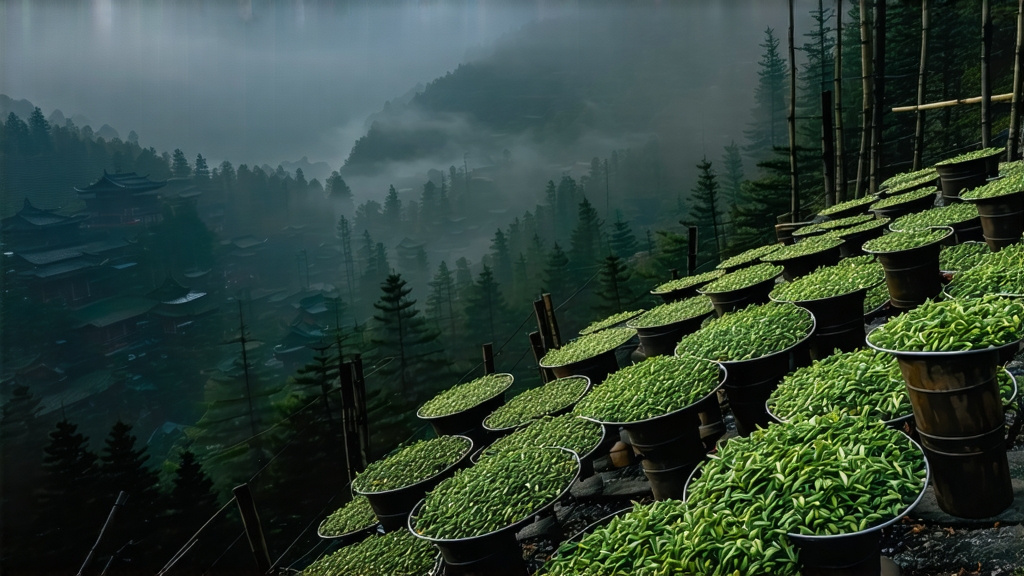
If you ask a Chinese tea master to name the first black tea ever created, the answer is always the same: Lapsang Souchong. Born in the cool, bamboo-veined gorges of the Wuyi Mountains in northern Fujian, this tea carries within its curled, pitch-black leaves the entire origin story of hong cha—what the West later labeled “black tea.” From the moment Dutch merchants unloaded the first chests in Amsterdam in 1604, Lapsang Souchong’s smoky perfume has drifted across four centuries of global trade, war, poetry, and even royal breakfast tables. Yet beyond the campfire aroma that made it famous lies a quieter, more nuanced leaf that Chinese farmers still finish by hand over embers of local Masson pine. To understand this tea is to taste both fire and mist, commerce and contemplation, in a single cup.
History: Smoke on the Maritime Silk Road
The exact year is lost in mountain fog, but village elders in Tongmu Guan (literally “Inner Pass of the Cypress Trees”) place the birth around 1568, late Ming dynasty. Bandits had disrupted the spring tea caravans; fresh leaves piled up in the factory, threatening to oxidize past the green-tea standard. A quick-thinking producer spread the leaf across pine racks above dying charcoal fires to arrest spoilage. The result—coppery liquor, longan sweetness, and a scent that reminded traders of Scottish peat—was an instant curiosity on the docks of Xiamen. By the early 1600s the Dutch East India Company had rebranded it “Bohea Tea,” a corruption of “Wuyi,” and shipped it together with porcelain and silks to Europe. Catherine of Braganza’s 1662 dowry to Charles II included a brass-bound chest of Lapsang Souchong, cementing its status as the aristocratic cup of Restoration London. When the British later planted tea in India and Ceylon they carried Lapsang’s blueprint—fully oxidized leaf—but never the pine smoke, which refused to travel.
Micro-terroirs: Three Families of Souchong
Today the European Union protects “Zheng Shan Xiao Zhong” as a product of designated origin; only leaf picked within the 60 km² national reserve surrounding Tongmu Guan may bear the name. Inside that boundary three stylistic families have evolved:
- Traditional Pine-Smoked (Yan Xun): Finished above resin-rich Masson pine for 8–12 hours, absorbing guaiacol and syringol molecules that create the signature tarry note.
- Modern Unsmoked (Wu Xun): A 2005 innovation requested by Fujian exporters seeking a sweeter, more accessible profile for Asian markets; dried with electric warm air yet still fully oxidized, yielding malt, honey, and longan.
- Wild Arbor (Ye Cha): Harvested from feral tea trees 2–3 m tall scattered through the reserve’s mixed forest; leaves are thicker, amber in the cup, with cooling camphor and orchid top notes that appear only when the tree is at least fifty years old.
Craft: Eight Stages from Leaf to Smoke
The journey begins before dawn, when pickers climb to 800–1 200 m elevation to pluck one bud and two leaves, the standard called xiao zhong. Once back in the plank-walled factory the craft unfolds in precise choreography:
- Withering: Leaf is laid on bamboo screens in the upper loft of the three-story building; mountain breeze and residual heat from the ground-floor pine fires reduce moisture to 60 % within four hours.
- Rolling: A 25-minute ride in a cast-iron trough breaks cell walls; the sap oxidizes within seconds, turning jade-green strips into coppery ribbons.
- Oxidation: The leaf rests 3–4 hours in cedar-lined boxes kept at 24 °C and 80 % humidity; polyphenols convert to theaflavins, painting the leaf chocolate-brown.
- Primary Firing: A 220 °C wok arrest oxidation in 3 minutes; the leaf is now called mao cha, rough tea.
- Sorting: Fans blow away stems and yellow flakes; only intact, glossy strips graduate to the smoking loft.
- Pine-smoking (optional): Workers spread 5 kg of mao cha across a sifter set 70 cm above a slow fire of 40-year-old Masson pine